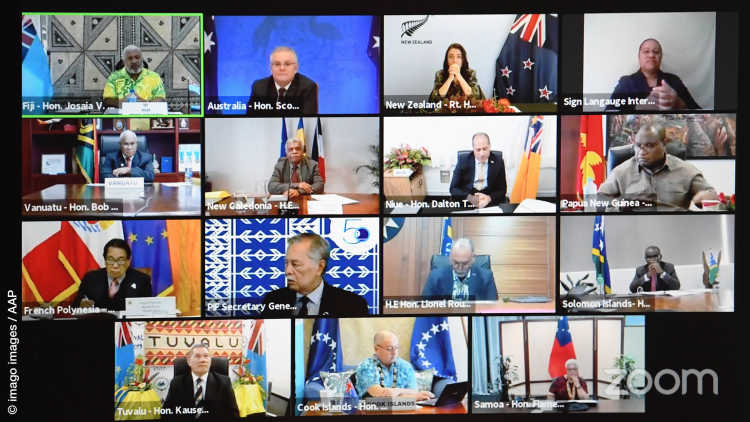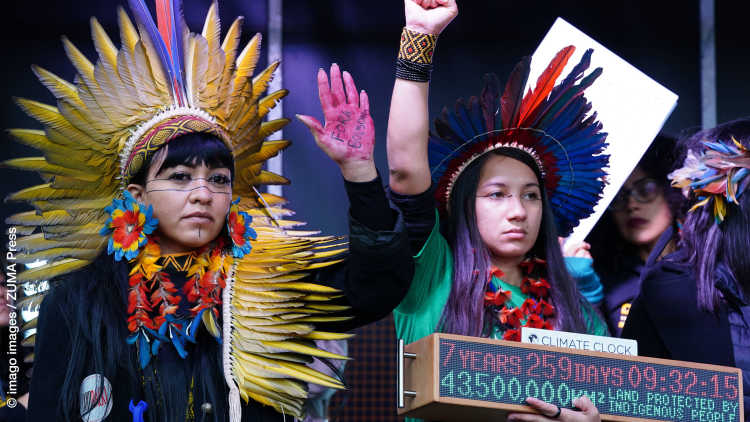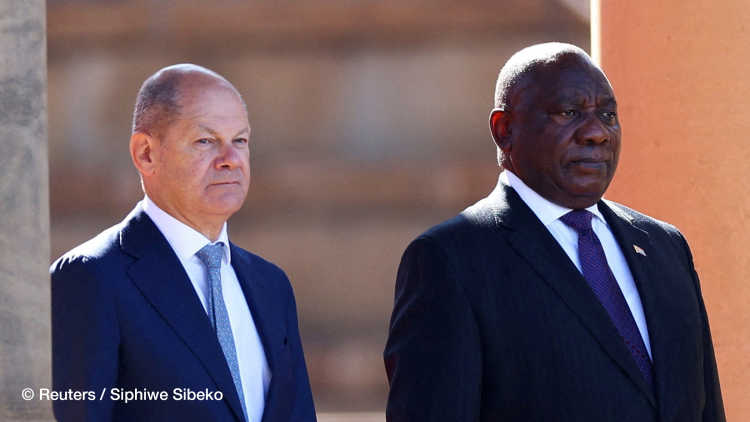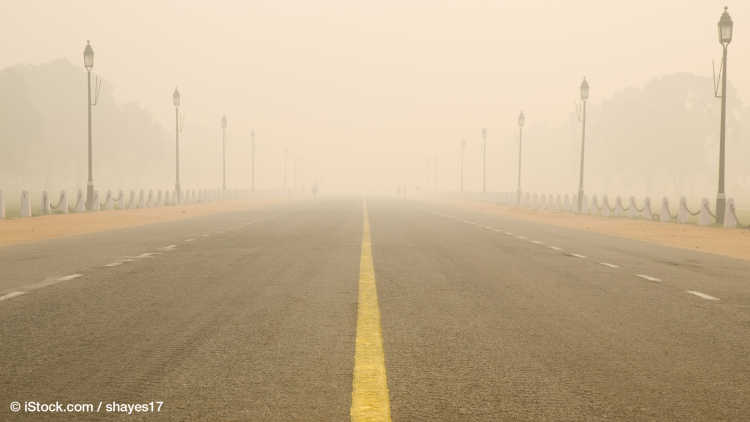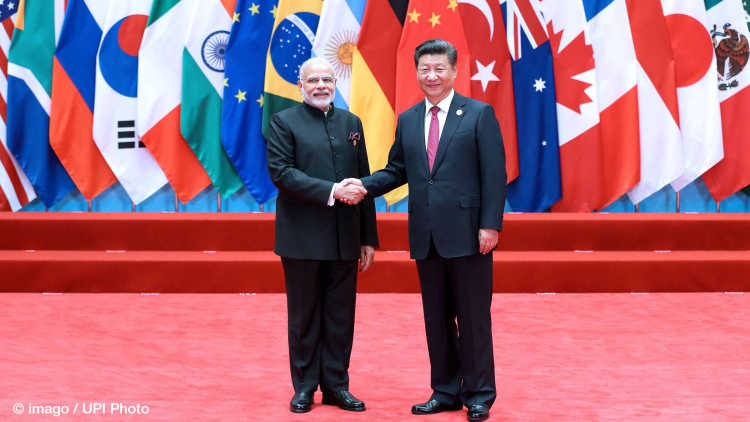- Home
- Publications
- GIGA Focus
- Requirements for a Successful COP 26: Commitment, Responsibilities, Trust
GIGA Focus Global
Requirements for a Successful COP 26: Commitment, Responsibilities, Trust
Number 7 | 2021 | ISSN: 1862-3581

On 1 November 2021, 197 countries will gather for the 26th Conference of the Parties (COP 26) to the United Nations Framework Convention on Climate Change (UNFCCC). This summit should have taken place in 2020 already but was postponed because of the COVID-19 pandemic. The agenda for this year’s event foresees, among other issues, the conclusion of negotiations on implementation rules for the Paris Agreement and the setting of more ambitious targets by the parties in their renewed nationally determined contributions.
Non-governmental organisations and countries from the Global South expect higher emission-reduction targets and greater financial contributions from developed countries. In turn, developed states expect emerging powers to contribute more as well. A strong mismatch between expectations and outcomes could inflict a serious setback on the climate change regime.
Countries were obliged to hand in updated emission targets by the end of 2020, but only 114 had actually done so by the time of writing. Observers have found the latest submissions of multiple big emitters to be insufficient.
In the context of the pandemic, countries from around the world have stressed the need for a “green recovery” and have mobilised significant capital to alleviate the crisis. However, short-term concerns regarding stabilising the conventional economy seem to outweigh environmental aspirations, particularly for big emitters with large, impoverished populations like Brazil, China, and India.
Many countries have struck a more moderate tone on contentious issues such as ideal approaches to international cooperation, but substantial disagreement remains.
Policy Implications
Diverging expectations and responsibility attributions are a significant obstacle for COP 26. European decision-makers need to enhance the trust developing and emerging countries feel towards them by making concrete additional commitments helping close the remaining finance and emission gaps. The latter could then follow suit and agree on an ambitious deal enhancing their own actions and concluding the remaining open negotiation items.
The Year 2021 in the Global Climate Regime
The COVID-19 pandemic has arguably had an enormous impact on the global climate regime. The 26th Conference of the Parties to the United Nations Framework Convention on Climate Change (COP 26) should have taken place in Glasgow last year already but was postponed to 2021. Climate change as a matter of public debate had received considerably less attention until the recent floods in the western part of Germany and the forest fires in the Mediterranean brought home to many the fact that it is not something only happening elsewhere in the world. Moreover, civil society actors like Fridays for Future have tried to keep the issue on the agenda, and many political actors – such as the European Commission or the new Joe Biden administration – issued Green New Deals and have declared a willingness to “build back better.” Countries from the Global South, including Argentina, Brazil, China, South Africa, and South Korea, have joined in a global wave of announcements to pursue carbon neutrality by approximately the middle of this century. Despite the barriers to conducting meetings in person imposed by the pandemic, these countries have continued to talk virtually in various formats: for example, the “June Momentum on Climate Change” events in June 2020, several workshops of the Subsidiary Bodies (SBs) throughout 2020, and the intersessional meetings in June 2021. This was meant to keep the conversation going even if no formal decisions could be taken.
When delegates finally gather in Glasgow in November, they will find a packed schedule on the agenda. First and foremost, there are some aspects of the Paris Agreement for which implementation rules are still missing. This includes specifications of Article 6 (market and non-market cooperative approaches), Article 8 (loss and damage), and Articles 13 and 14 (transparency and common reporting formats). Additionally, delegates are supposed to discuss the level of ambition indicated by their updated nationally determined contributions (NDCs) – both in terms of mitigation of greenhouse gas (GHG) emissions and financial support. Expectations about the sharing of burdens, the need for compromise, and the overall required level of ambition diverge both among states and between their coalitions, activists, and other observers. While, collectively, a big step towards the solution of the climate crisis needs to be made this year, expectations about required individual actions are not only distributed unevenly among countries but often are diametrically opposed too. Yet, expectations and the way in which they are met or not matter for the results of the process.
Responsibilities in Climate Change Negotiations
While the notions of “responsibility” or being a “good citizen” have emerged in various issue-areas of global governance, with increased expectations vis-à-vis the so-called emerging powers, these calls are both particularly pronounced but also potentially conflictive in the global climate change regime. This is mainly because the challenge that regime faces is characterised by a so-called triple inequality (Roberts and Parks 2006: 7). First, there is inequality – and hence potentially injustice – in who has contributed to or caused the problem. Second, there is inequality in the capacity to do something about the problem. Third and finally, there is inequality in the capacity to deal with the potential fallout: namely, in providing adaptation to nature and population. Hence, how burdens are shared – and thus how, in sum, financial contributions and obligations are spread around – depends on who is considered “responsible” regarding these diverse inequalities.
Responsibility can take on various meanings, including a “backward-oriented” version that looks specifically at who, historically, has contributed most to causing the problem at hand, and a “forward-looking” frame that is oriented towards those who have the capacity to prevent major and lasting damage. A focus on historical responsibility brings with it the redistribution of resources, for instance in terms of compensation or of enabling others to react to a problem to which they barely contributed in the first place. A focus on capacities, or action-based responsibilities, leads to different expectations and demands, ones disregarding the past – at least to a certain degree. These two different understandings of responsibility clearly lead to varying expectations about who should justifiably do (or pay for) what. Their existence is reflected in the diverging interpretations of one of the core norms of the climate regime: the allocation of burdens and commitments according to “Common But Differentiated Responsibilities and Respective Capabilities” (CBDR-RC). CBDR-RC has been operationalised in the past through differentiation, both of the kind and scope of commitments for the mitigation of GHG emissions, as well as the provision of finance, capacity-building, and technology transfer mostly to those who bear less responsibility for causing climate change and who could otherwise not afford to take action.
With the introduction of bottom-up governance approaches in the Paris Agreement, the division between developed and developing nations has become blurred. Rather than top-down agreements on the commitments and obligations of different categories of states, participating members of the UNFCCC now contribute their individually determined “fair share” according to NDC targets, which responds much more to a capacity-oriented understanding of responsibility. Yet, this shift has not made the negotiation of responsibilities and legitimate expectations regarding action any easier; if expectations and attributions of responsibility constantly meet disappointment or go unmatched, mistrust is the result. In fact, the failure among industrialised states to uphold many previous commitments, above all financial, has led to a significant lack of trust in the negotiations. This has been particularly pronounced in the relationship between countries of the so-called Global North and Global South. This conflict line has been a major factor in climate change negotiations, leading to a lack of commitment and a circular shifting of blame. It is, hence, important to continuously gain insight into expectations and attributed responsibilities, and to create a shared pool of knowledge on these issues.
A first step in this direction is taken here, mapping the responsibility attributions on core issues at stake at COP 26; how far they converge or diverge is assessed, and an outlook offered on how likely agreements on these issues are. Focus is on three dimensions for which these dynamics of responsibility have been particularly relevant in the current preparatory phase of the summit, and which are likely to be discussed extensively in Glasgow itself: the discussion of the need to increase ambitions; the long-burning issue of climate finance; and the resolution of the gridlock surrounding Article 6.
Responsibilities for Enhanced Mitigation Ambition
Among the main tasks set by the Paris Agreement is that countries are required to regularly discuss and increase their mitigation ambition, also at COP 26. The Paris Agreement does not impose fixed negotiated targets for mitigation and other goals; each country determines its own targets, which must be updated every five years. Each update, moreover, must be a progression compared to the previous iteration. The year 2020 was the first time that countries had to hand in these new NDCs. As noted, at the time of writing 114 countries had submitted such an update, which means not even half of the parties to the Paris Agreement have complied with this provision. Most of the missing NDCs are from African and Middle Eastern countries, but also some other major emitters like India have yet to contribute too. China has announced targets that would be a progression on its previous commitments, but it still needs to submit them formally. Other major emitters from the Global South such as Brazil, Indonesia, and Mexico have not increased the ambition of their NDCs according to the assessment of the Climate Action Tracker (2021; see also, Figure 1 below). For many developing countries, missing the deadline for NDC submission has been justified by strained resources due to the pandemic, limiting their ability to access and produce the necessary information to develop new options and targets.

The picture is also mixed regarding contributions from the Global North. Australia, for instance, has not increased its mitigation target but agreed to refrain from using its carbon-emission rights from the Kyoto Protocol mechanism. The United States re-joined the Paris Agreement and announced an emission-reduction target of 50–52 per cent below 2005 levels by 2030. Observers welcomed this more ambitious contribution, but conclude also that the country needs to reduce its emissions by the greater figure of 57–62 per cent if it is to contribute its fair share to the collective effort. Japan and the European Union received similar assessments. Generally, countries have engaged in a wave of pledges for carbon neutrality or net-zero emissions vis-à-vis their economies by 2050 in the run-up to the deadline, from industrialised countries such as Canada and Germany to developing and recently developed states such as Argentina and Fiji. It remains open how realistic these goals are, and the status and bindingness vary extensively across countries who have made such a pledge (Darby and Gerretsen 2021).
When announcing their targets, most actors also added some expression of what they expected from others: The EU, for example, assumes that Asian countries will follow suit once China commits to a higher level of ambition regarding mitigation efforts, thus the bloc’s goal is to “lure China into the best possible announcement they can make” (Farand 2019), as a senior EU official put it. A German diplomat also stressed that “a more ambitious NDC from China […] would be a very important signal for international climate policy” (Waldholz 2020), which the German minster for the environment, nature conservation and nuclear safety, Svenja Schulze, both seconded and extended in a tweet saying that she believed in the EU’s ability to get other big emitters engaged as well. Such expectations are based on China’s major-emitter status, and the latter country could maintain the solid reputation it has developed in this field recently. Increasing ambition this way would require some reciprocity from the US, not to mention mutual trust – as Chinese vice premier Han Zheng also told the US climate envoy, John Kerry, in a recent video call (Buckley and Friedman 2021).
Chinese officials such as Vice Foreign Minister Le Yucheng have acknowledged the expectations of others too, albeit immediately qualifying them: “Some countries are asking China to fast forward the process. That, I am afraid, is not very realistic […]. It is against the natural course of things if you ask these two groups of students to graduate at the same time” (Global Times 2021). This alludes to the differences in development levels that still exist between China and the countries of the Global North, rejecting therewith notions of equal obligations to urgently mitigate emissions. Instead, China expects the US “to redouble their [sic] efforts to make up for the time lost during its absence” (Global Times 2021). Simultaneously, observers have mentioned that China paints its own current efforts as taking on quite a big portion of responsibility.
India also traditionally champions the idea of historical responsibility, meaning the duty of developed countries to lead in mitigation efforts and financially support less developed peers. When confronted with the question of emerging economies’ expectations of the Global North regarding mitigation ambitions, Environmental Minister Prakash Javadekar responded: “Historically, it’s the developed countries that have been major contributors to carbon emissions. […] Even though India has not been the reason for climate change, we have responsibly addressed the issue and have taken strong measures to curb our carbon emissions and to meet goals set by the Paris Agreement” (Express News Service 2020). In another instance, he suggested to “ask the countries lecturing us to mend their own ways instead” (Joshi and Jaiswal 2020), as they were not compliant with the Paris Agreement. Other Indian decision-makers including Prime Minister Narendra Modi have either promised to overachieve on the set targets or admitted room for improvement regarding ambition.
One way to bridge these tensions would be to enhance developing-country mitigation via financial aid from developed peers, even if climate finance continues to be one of the most conflictual issues within the global climate regime. This leads us to our second topic of responsibilisation.
Responsibilities for Fairness and Justice in Sharing the Financial Burden of Mitigation and Adaptation
Both mitigation and adaptation require extensive financial resources, ones currently unequally distributed among states. In addition to uneven contributions to the causes of climate change, this has made climate finance one of the crucial and most contested aspects of related negotiations. Developed countries pledged to mobilize USD 100 billion annually by 2020, which they later decided to provide through the Green Climate Fund (GCF). Yet, current pledges for the period 2020–2023 only amount to USD 9.5 billion (including leverage : USD 23.8 billion), which does not suffice to fund the USD 30.3 billion worth of projects now in the pipeline (GCF 2021). To fill the gap, an additional USD 2.6 billion in state contributions would be needed. However, USD 30.3 billion is still less than one-third of the finance promised in the Cancun pledge; to match this commitment, states would have to deposit a total of USD 40 billion with the GCF, instead of the USD 9.5 billion they have actually contributed so far.
The question in this context is who countries expect to fill the consistent financial gaps existing today. Generally speaking, the fulfilment of the Cancun pledge is part of the climate-justice argument: As developing countries have historically contributed much less to climate change, are more vulnerable to it, and furthermore lack the financial resources to mitigate and adapt to the phenomenon, developed peers are supposed to erase their historical debt via financial support. Some of the obvious donors have explicitly stated their readiness to contribute further financial resources to the global effort. Yet, German chancellor Angela Merkel said at the Petersberg Climate Dialogue that “already in 2019, Germany has overachieved on its commitment to double its publicly funded contribution to EUR 4 billion by 2020. […] The German contribution from all sources – public and private – amounted to EUR 7.6 billion. I think this is a fair contribution” (Federal Ministry for the Environment, Nature Conservation and Nuclear Safety 2021). The implication here is that it is not Germany’s responsibility to provide additional funding.
The new US administration announced in September 2021 at the UN General Assembly that it would quadruple its international climate finance by 2024 compared to the contributions under the second Barack Obama administration, corresponding to USD 11 billion (The Guardian 2021). In comparison, smaller countries like Germany or Canada contributed USD 4.7 billion and USD 4.4 billion respectively for the initial resource-mobilization phase. Both of the latter have pledged less for the GCF’s first replenishment, however (see Table 1). President Biden committed to mobilising sufficient funding nevertheless: “We need to ensure that the financing will be there, both public and private, to meet the moment on climate change and to help us seize the opportunity for good jobs, strong economies, and a more secure world” (Igoe 2021). Without more concrete financial commitments, however, the significant shortfall vis-à-vis the Cancun pledge remains.

Nevertheless, countries of the Global South typically do not publicly call on individual developed peers to upscale their financial contributions; rather, they remind them as a group of their financial promises. An Indian delegate at the sessions of SB 2021 instantaneously insisted that “developed countries need to honour their USD 100 billion commitment” and this amount was the “floor” for future commitments, for which developed countries should produce a road map – one ideally focused on capacity-building (own data collection). A key source of persistent mistrust is the past lack of financial flows having accumulated, as argued by an Indian delegate on behalf of the BASIC (Brazil, South Africa, India, China) coalition: “It was decided that every year the world will set aside 100 billion USD for developing nations to combat climate change. But now more than one trillion USD is pending. Technology transfer is not happening” (Deccan Herald 2020). Various developing countries at SB 2021 also insisted that the Cancun pledge funding was supposed to be “new and additional” rather than part of the regular budgets for development cooperation.
As a result, the developed countries would have to “demonstrate trust” in developing peers to use any additional funding accurately and for best purpose, as the coalition of Like-Minded Developing Countries (LMDC) put it at one point in the closing session of SB 2021. The expected forms of aid could include the revenue from the international-cooperation mechanisms foreseen in Article 6 of the Paris Agreement – a provision which awaits implementation rules.
Responsibilities to Resolve Gridlock on Article 6
During COP 25, Article 6 was the most publicly debated topic and perceived as the summit’s most contentious item. It is supposed to regulate international cooperation on mitigation, such as emission-trading schemes or developing-country projects funded directly by public or private entities from developed peers. The core conflict here is twofold. First, who gets to claim the reduced emissions: the donor countries or the recipient implementing the project within its borders. Alternatively, each of the cooperating countries could be assigned a share of the emissions. Second, some countries contested whether certified emission rights (CERs) from the expiring Clean Development Mechanism (CDM) of the Kyoto Protocol can be carried over to the new emission-trading system. Countries in favour of such a carry-over stress that these are real, already-achieved emissions savings. Opposing parties emphasise that these emissions savings were to be utilised for the mitigation targets of the Kyoto Protocol through 2020. Thus, carrying CERs over to the Paris Agreement mechanism would mean to count the emission savings twice: once each for the time before and after 2020 respectively.
In Madrid, Australia, Brazil, and the US insisted on their right to carry over their “old” credits and reduce the amount of GHG emissions they would have to mitigate as part of their current NDCs. Other countries opposed this stance, leading to gridlock on Article 6 in its entirety – even on those aspects that all parties previously agreed with. Article 6 thus is a key point needing resolution for negotiations to move forward at COP 26. There has already been some movement here, as the Australian government recently announced it will refrain from using its old CERs to fulfil its NDC target (Climate Action Tracker 2021); the new US administration entertains more ambitious, less obstructive language on the issue meanwhile. Brazil is the remaining party held responsible for obstructing a solution to the issue; it has, however, also struck a more modest tone in negotiations recently, concentrating on technical details.
Nevertheless, it remains unclear whether Brazil still intends to insist on using its CERs to meet its NDCs. A Chinese delegate at SB 2021 announced that: “Some parties [not including China] have admitted to wanting to use CDM to fulfil their NDCs, and I think we should be more ambitious than that” (own data collection). Saudi Arabia, on the other hand, announced on behalf of the LMDC – earlier in the same session – that some coalition members would be interested in using their CERs to this end. As a result, it is to be expected that multiple countries could prolong the existing deadlock. To push for resolution, particularly in the light of the acute financial challenges resulting from the COVID-19 crisis, some developing countries have reiterated the importance of being able to use the revenues from the Article 6 mechanism to boost their climate-related activities as soon as possible.
For example, the LMDC coalition stated at SB 2021 that the proceeds from Article 6 will have to be reinvested in developing countries to both enable economic recovery and maintain a basic ability to adapt to the adverse effects of climate change already occurring in many places worldwide. This would not yet account for the resources needed for a “green recovery” from the pandemic, as proposed by many developed countries. In the opinion of developing peers, the international community would accordingly need to operationalise Article 6 by the end of 2022 to bridge the gap to the necessary mitigation, adaptation, and loss- and damage-related efforts by developing countries.
Implications for a Successful Summit in Glasgow
In a nutshell, perspectives on responsibility continue to differ widely. While countries from the Global North intend to get especially China to commit to greater climate ambition, they are themselves accused of not doing enough by Global South peers. Many countries, further, have as noted not yet (formally) submitted their updated NDCs, including China and India. Regarding climate finance, the entrenched differences about appropriate levels of funding continue to stir conflict: while developed countries provide sufficient capital for the GCF projects now in the pipeline, their financial commitments still fall short of the Cancun pledge of USD 100 billion per year. Countries of the Global North, however, regard their contributions to represent a fair share, and point to private investment and their increased regular development-cooperation budgets. Finally, viewpoints regarding possible compromise on Article 6 also deviate. Although some countries share a keen interest in the position of Brazil on the matter, it seems the latter is regarded as the only country that will potentially insist on maintaining its veto.
This means that the weather forecast for COP 26 is “cloudy, with potential for rain.” With major conflicts looming on Article 6, there is acute uncertainty about whether the Paris Agreement rulebook can be finalised in the third overdue year. The softer and serious tone struck by many countries leaves us cautiously optimistic, at least, about readiness to compromise on this topic. On mitigation ambition in the new NDCs, we expect most countries that have not yet (formally) delivered an updated version to submit one either just before or during the course of COP 26. Both the US and European NDCs will likely remain within the scope of what they have already submitted, while China could increase its NDC ambition with a formal version thereof still pending. The most important wild card remains India, which has not given away any substantial insights on its upcoming NDC. On finance, the arguments have changed little over the last decade, so we do not expect a surge in contributions during the COP unless its presidency somehow manages to induce a new political dynamic.
Nevertheless, there is still hope of the sun coming out at COP 26: A behind the doors deal between the US and EU on the one side and the big emitters China, Brazil, and India on the other is a possibility. In such a deal, the former would exchange concrete and significant additional financial contributions from the developed countries for mitigation ambition from China and India, as well as a compromise from Brazil on Article 6 rules. Such a significant deal, however, needs trust, as China and others have emphasised. To this end, especially China and the US must find a way to sufficiently disentangle the climate talks from their own geopolitical tensions to make that outcome happen. Additional ambition from big emitters is not to be expected if it appears that they have, ultimately, merely bowed to the demands of the Global North.
Footnotes
References
Buckley, Chris, and Lisa Friedman (2021), Climate Change Is ‘Not a Geostrategic Weapon,’ Kerry Tells Chinese Leaders, in: The New York Times, 2 September, sec. World, www.nytimes.com/2021/09/02/world/asia/climate-china-us-kerry.html (11 September 2021).
Climate Action Tracker (2021), CAT Climate Target Update Tracker, 9 February, https://climateactiontracker.org/climate-target-update-tracker/ (19 October 2021).
Darby, Megan, and Isabelle Gerretsen (2021), Which Countries Have a Net Zero Carbon Goal?, in: Climate Home News, 7 July, www.climatechangenews.com/2019/06/14/countries-net-zero-climate-goal/ (16 August 2021).
Deccan Herald (2020), India Not Responsible for Climate Change; Contributes Only 6.8% of Global Emissions: Javadekar, 11 December, www.deccanherald.com/national/india-not-responsible-for-climate-change-contributes-only-68-of-global-emissions-javadekar-926174.html (16 August 2021).
Express News Service (2020), India Didn’t Cause Climate Change: Prakash Javadekar, in: The Indian Express (blog), 12 December, https://indianexpress.com/article/india/india-didnt-cause-climate-change-prakash-javadekar-7101545/ (16 August 2021).
Farand, Chloé (2019), EU Plots Climate Deal with China, in: Climate Home News, 11 November, www.climatechangenews.com/2019/11/11/eu-plots-climate-deal-china/ (16 August 2021).
Federal Ministry for the Environment, Nature Conservation and Nuclear Safety (2021), High-Level-Segment des 12. Petersberger Klimadialogs, in: bmu.de, 5 June, www.bmu.de/MD1512 (3 September 2021).
GCF see Green Climate Fund
Green Climate Fund (2021), Approved Projects. Text. Green Climate Fund, 25 March, www.greenclimate.fund/projects (10 September 2021).
Global Times (2021), China, US Commit to Climate Cooperation amid Strained Ties, 18 April, www.globaltimes.cn/page/202104/1221310.shtml (16 August 2021).
Igoe, Michael (2021), Biden Announces US Will Double Climate Finance by 2024, in: Devex, 22 April, www.devex.com/news/sponsored/biden-announces-us-will-double-climate-finance-by-2024-99729 (16 August 2021).
Joshi, Madhura, and Anjali Jaiswal (2020), Climate Action: All Eyes on India, in: NRDC, 12 December, www.nrdc.org/experts/anjali-jaiswal/climate-action-all-eyes-india (3 September 2021).
Roberts, J. Timmons, and Bradley Parks (2006), A Climate of Injustice: Global Inequality, North-South Politics, and Climate Policy. Global Environmental Accord: Strategies for Sustainability and Institutional Innovation, Cambridge, MA, USA: MIT Press.
Waldholz, Rachel (2020), Hopes for EU-China Climate Deal Centre on Green Recovery, in: Clean Energy Wire, 16 June, www.cleanenergywire.org/news/hopes-eu-china-climate-deal-centre-green-recovery (10 September 2021).
General Editor GIGA Focus
Editor GIGA Focus Global
Editorial Department GIGA Focus Global
Regional Institutes
Research Programmes
How to cite this article
Prys-Hansen, Miriam, and Jan Klenke (2021), Requirements for a Successful COP 26: Commitment, Responsibilities, Trust, GIGA Focus Global, 7, Hamburg: German Institute for Global and Area Studies (GIGA), https://nbn-resolving.org/urn:nbn:de:0168-ssoar-75501-2
Imprint
The GIGA Focus is an Open Access publication and can be read on the Internet and downloaded free of charge at www.giga-hamburg.de/en/publications/giga-focus. According to the conditions of the Creative-Commons license Attribution-No Derivative Works 3.0, this publication may be freely duplicated, circulated, and made accessible to the public. The particular conditions include the correct indication of the initial publication as GIGA Focus and no changes in or abbreviation of texts.
The German Institute for Global and Area Studies (GIGA) – Leibniz-Institut für Globale und Regionale Studien in Hamburg publishes the Focus series on Africa, Asia, Latin America, the Middle East and global issues. The GIGA Focus is edited and published by the GIGA. The views and opinions expressed are solely those of the authors and do not necessarily reflect those of the institute. Authors alone are responsible for the content of their articles. GIGA and the authors cannot be held liable for any errors and omissions, or for any consequences arising from the use of the information provided.





